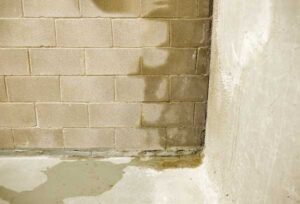

Distinguish Seepage from Condensation
A moist basement does not always mean a problem with your waterproofing. This is because sometimes moisture does not get in from the exterior but comes from excessive moisture within the interior of the basement. To determine the source of the moisture, tape an aluminum foil in the middle of your basement, at a place that is usually moist. Leave it there for 2 to 3 days and then remove the same. If the area where the foil was placed is wet, but the surrounding area is dry, then you have a waterproofing issue. If the area where the foil was placed is dry, but the surrounding area is wet, then you have a problem with condensation.
Assess the Situation
It is important to remember that you can DIY but only if the damage is not extensive. If the reason for your moist or flooded basement is because of serious structural problems, then you need to hire a professional. However, if your problem is just a bit of moisture coming from small cracks in the floor, wall and ceiling of your basement then repairing the damage can be done via DIY.
Prepare the Surface Area
If your basement is prone to moisture, molds, and mildew and there is no serious crack in the structure, then what you need to do is recoat or coat the surface with waterproofing materials. Clean the entire surface area by scrapping, chipping off, brushing any loose materials, powdery cement, caked paint, dust, molds, grease, etc. It is crucial to focus on points that are prone to moisture, but it is imperative that you check every bit of your basement to ensure you do not miss a crack or two.
Select the Materials to Use
There are several to choose from (i.e. paint, cement, sealants, etc.). Bear in mind that different types work with different problems. It is important to inquire with your local hardware store for some tips regarding this. Remember, before buying the waterproofing materials you need to carefully read the label and make sure that what you are purchasing is sufficient for your purpose. Also, before applying, make sure to follow the instructions to the letter. There are no shortcuts or alternatives for a “DIYer.” You either follow the instructions painstakingly or fail in your project completely.
Water Repellent vs. Waterproofing
Water repellent allows the water to slide off the surface with the least amount of resistance and drop to the lowest point. This is not the same as basement waterproofing, which allows no moisture to seep into the interior from the exterior. However, by using both repellent and waterproofing , you can ensure that any water that does hit the exterior surface does not have a chance of seeping into unnoticed cracks and onto your interior. One last thing, once you have totally sealed up your lower level and no new moisture is coming in, you may still have a problem with mold and mildew. This is very difficult to get rid of on your own. If your basement still shows signs of mold growth, mold removal professionals can help get rid of it and make your downstairs level healthy and livable again.
SANI-TRED has been used by over 100,000 Do-It-Yourself customers to waterproof their basement

